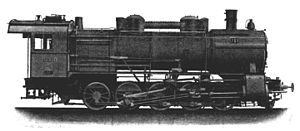Saxon XI HV
| Saxon XI V, XI H, XI HV DR series 57.0–2 FS 474 |
|
|---|---|
|
Saxon XI H, built in 1905, road number 701
|
|
| Numbering: | Saxony: DR 57 001-014, 021-083, 101-105, 201-218 FS 474.001 |
| Manufacturer: | Hartmann |
| Year of construction (s): | 1905-1918 |
| Retirement: | 1930s |
| Type : | E h2v |
| Length over buffers: | 18,376 mm |
| Service mass: | 73.1 t |
| Friction mass: | 73.1 t |
| Wheel set mass : | 14.8 t |
| Top speed: | 50 km / h |
| Indexed performance : | 894 kW |
| Driving wheel diameter: | 1260 mm |
| Number of cylinders: | 2 |
| HD cylinder diameter: | 590 mm |
| LP cylinder diameter: | 860 mm |
| Piston stroke: | 630 mm |
| Boiler overpressure: | 13 bar |
| Grate area: | 3.29 m² |
| Evaporation heating surface: | 200.60 m² |
| Tender: | sä 3 T 9/12/13 |
| Water supply: | 9.0 / 12.0 / 13.0 m³ |
The steam locomotives of the Saxon classes XI , XI and XI were five-fold coupled tender locomotives of the Royal Saxon State Railways .
history
The Deutsche Reichsbahn used many machines until the 1930s. They had the road numbers 57 001-014, 57 021-083, 57 101-105 and 57 201-218.
A number of locomotives had to be surrendered after the First World War and ended up in Belgium ( SNCB ) (11), Italy ( FS ) (6 or 7) and France ( PO ) (29). After the SNCF was founded in 1938, the locomotives in France were to be renamed as 050-A-532 to 534 (XI H), 050-B-535 to 549 (XI V) and 050-C-550 to 560 (XI HV). However, this should also have affected former FS locomotives. XI HV 894 came to Italy as a reparation payment , where it was designated as FS 474.001 and stationed in Bussoleno . It was retired in 1948.
Constructive features
The machines were designed for freight train service on routes with few bends. Therefore, the Gölsdorf principle of laterally movable coupling axles was applied. In the first series, the first, third and fifth coupling axles were movable, and the fourth coupling axle was used as a driving axle. For later deliveries, only the first and fifth coupling axles could be moved laterally and the third axle became the driving axle.
In order to find out which type of steam engine is the most suitable, the Sächsische Maschinenfabrik initially produced three different types. Outwardly, there were no noticeable differences. A total of eight examples of the XI H series with a two-cylinder superheated steam engine, 108 of the XI V series with a two-cylinder wet steam engine and 31 of the XI HV series with a two-cylinder superheated steam engine were produced between 1905 and 1918. 28 units were later converted to superheated steam engines.
The XI V were with Tender senders of types SAE 3 T 9, T 12 SAE 3 or SAE 3 T 13 coupled.



